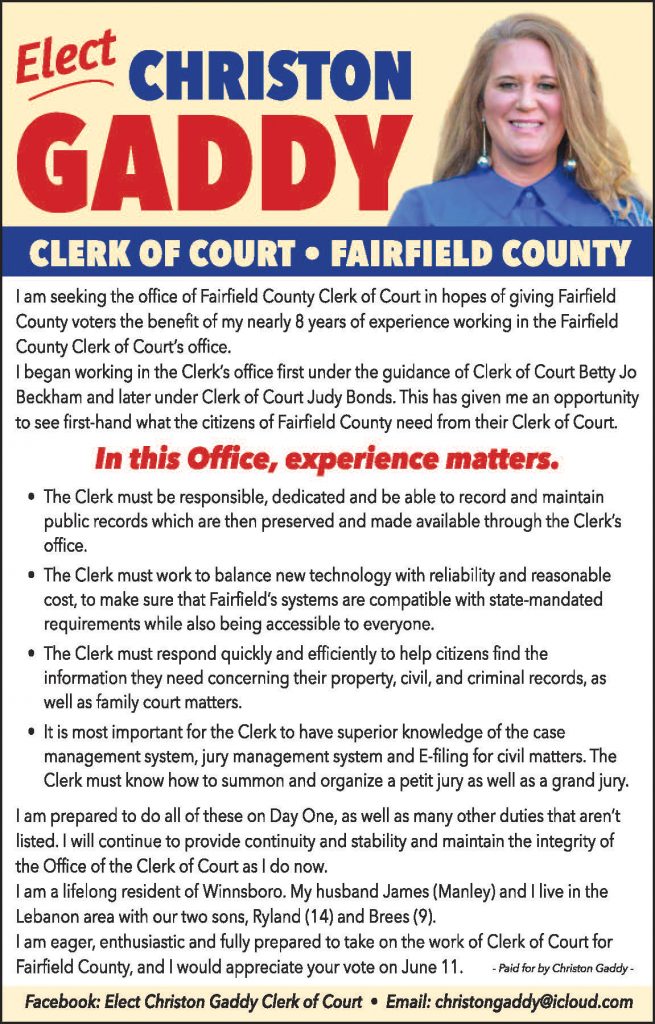FAIRFIELD – At a County Council meeting on July 8, county taxpayer Maggie Holmes accused Fairfield County Council of mishandling millions of dollars of Local Option Sales Tax (LOST) revenue since it began collecting the tax in 2006. On July 29, the County brought in two consultants from Parker Poe Consultants with expertise in the field of LOST funds to address those accusations. Ray Stevens, a former head of the S.C. Department of Revenue, told citizens attending the Council meeting that the County had credited the LOST revenue to tax payers, but that it appeared the County was crediting it in two phases — when the millage was set in May or June and again on their tax bills in the fall. But he stopped short of saying the County had mishandled the LOST revenue or explaining whether the County had unlawfully accumulated much of the County’s LOST revenue in the General Fund over the years.
The evidence, however, is piling up that, since 2006, the County may, indeed, have mishandled its LOST funds in two ways — first, by grossly underestimating how much LOST funds it expected to receive each year, and second, by failing to return all of each year’s LOST revenue to the County’s property tax payers in the form of property tax credits.
According to documentation provided to Maggie Holmes through a Freedom of Information Act request last March, former County Administrator Philip Hinely’s estimation of how much revenue he thought Fairfield County would receive each year from LOST revenue directly affected how much tax credit would be subtracted from tax payers’ annual property tax bills. The lower the estimate, the lower the tax credit that would be applied to each bill. The excess revenue that resulted from the low estimates accumulated from year to year in the General Fund. Such an accumulation, if it occurred, is a violation of state law.
According to that documentation provided to Holmes by Hinely, a little more than $5.2 million of the LOST revenue accumulated in the General Fund between 2006 and 2012.
About two weeks after Holmes made her accusations to Council, however, it was discovered by Holmes’ attorney and, perhaps by the County’s various hired consultants, that the $5.2 million amount might not be correct. The County, it appeared, was inadvertently, and apparently unknowingly, returning twice the amount of tax credit to tax payers that it had intended to return.
It seems the equivilent of a LOST tax credit was first being given in May or June each year in a calculation error as millages for all County agencies were totaled in preparation for County Council to vote on the Resolution Establishing the total Millages for the County. The net County millages (the amount of millage needed after the tax credit was deducted from the gross millage) was added into the calculation of the total millage for all County agencies instead of the gross millage (the total millage needed to operate the County’s General Fund.) Then the LOST tax credit was deducted as it should have been–only on the property tax bill when it was prepared in October. The result was an unintended double deduction.
According to Laura Johnson, the County’s Comptroller, the County’s Comptroller, the calculations for the Resolution were prepared by Hinely in conjunction with her Department in late May or early June. But Johnson said she was unsure how the final millage amount was calculated.
“That’s one of the things the County Administrator [Interim Administrator Milton Pope] and the auditors are looking at now,” Johnson said. “As soon as their report is completed, then we’ll know what happened.”
The double deduction presented two problems, according to Holmes — that the error had been made each year without detection since 2006, and that it was actually an indication that a large amount of LOST revenue was being accumulated in the General Fund each year.
“The deduction was given twice and there was still a large overage of LOST funds going into the General Fund,” Holmes said. “It just wasn’t as much as we first thought.”
Underestimated LOST revenue
According to S.C. Statute 4-10-10, the law specifies guidelines for how to estimate the annual LOST tax revenue. It directs the estimate is to be based on how much LOST revenue was received the prior year. For example, the County received $1,812,814.73 in LOST revenue in 2010. So it should have based its estimate of LOST revenue for 2011 on that 2010 amount. Instead, the County estimated its 2011 LOST revenue at $908,495.51, approximately half the amount of LOST revenue it received in 2010.
In correspondence to Holmes, Hinely listed a number of reasons why he estimated each year’s LOST revenue so low — fear of a weak economy, fear of certain provisions of Act 388 that “if the County overestimates the tax credit or if collections decline and lower the millage rate greater than it should, the County cannot make the appropriate adjustment to our millage,” fear of a fluctuation in tax revenue, etc.
But several CPAs, auditors and a Director of Finance of a municipality, all of whom work with LOST revenue but asked not to be named, told The Voice that those fears are generally unfounded, pointing out that Fairfield County’s LOST revenue has continued in an upward trend even during the down economy years of 2008-2010.
Furthermore, state law dictates that a county or town’s LOST tax revenue cannot be less than it was the previous year. One source told The Voice that this level of assurance is further provided by an equalization of LOST revenue among counties by the Department of Revenue after it collects the tax and before it sends the tax revenue to the County Treasurer.
Failed to give taxpayers timely tax credits for LOST revenue
It appears, according to the documentation Hinely provided to Holmes, that after greatly underestimating its LOST revenue, the County then siphoned off the overage and accumulated that overage from year to year in the County’s General Fund. As an example, after taking the 2011 estimate of $908,495.51 from $2,152,551.64 (the actual LOST revenue received in 2011), the County had an overage or ‘difference’ of $1,244,056.13. An accumulation of LOST funds from year to year is in violation of state law.
“What’s most shocking about this, is that even with a double credit, there was still, apparently, a large amount of LOST revenue in excess of the County’s estimate that was held in the County’s General Fund,” said Jonathan Goode, Holmes’ attorney. “This shows how far off the County was in its estimates of how much of the LOST revenue to hold back.
“If not for the double credit,” Goode said, “the County would have been giving taxpayers credit for less than half what it received in LOST funds. By estimating too low, a huge amount of excess is created. If that excess is not given back to the taxpayers in a timely manner in the form of property tax credits as required by law, this creates a gross influx of dollars to the General Fund.”
While County taxpayers, and perhaps many in the County Administration, are waiting to learn from the auditors the final numbers of how much of Fairfield County’s LOST revenue was withheld and accumulated in the General Fund, Holmes said that, “just because the County was apparently giving tax payers a double credit of what they intended to give each year, that is not OK. Almost all of that tax credit should have been coming back to us each year. Something was wrong.”
And, indeed, there may be no better proof that something was wrong than the fact that, since 2006, the LOST tax credit has hovered around 7 – 8 mills based on an $800,000 – $900,000 LOST estimate. After Holmes brought the subject up to Hinely and subsequently to Council, this year the LOST tax credit will jump to 21.37 mills for FY2014 based on a $2,400,000 credit from the General Fund.












